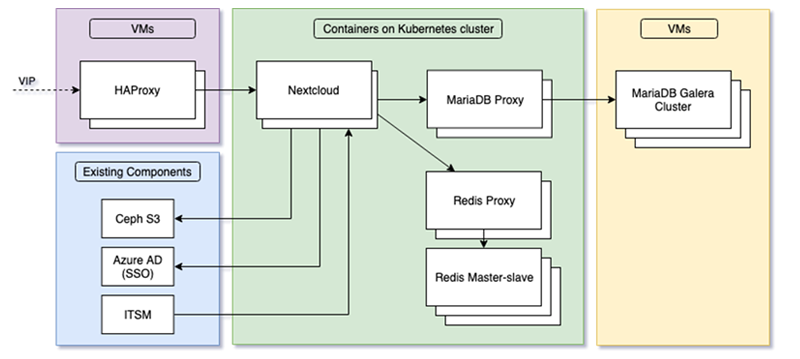
Aptira previously built a large Ceph storage cluster for Swinburne. While the Ceph storage has been reliable, Swinburne wanted to offer a Dropbox-like user experience for staff and students on top of this on-premises storage.
The Challenge
Swinburne wanted to improve access to the Ceph storage in a number of ways:
- Improve ease-of-use and features for users: the standard storage protocols offered by Ceph are not readily accessible by less technical users. Swinburne wanted to make storage available to a broader cohort of users by adding a user-friendly interface with sharing and collaboration features.
- Reduce the maintenance required of their IT services department to manage it: At the time Swinburne were using a variety of methods to provision access to storage – all of them requiring manual steps before the storage could be delivered to a user. Keeping track of the current storage allocations had also become a burden for staff.
- Integrate authentication with their existing Azure AD system: Allow users to login via SSO.
- Integrate storage account requests into their existing ITSM system to enable self-service provisioning for users.
Swinburne had identified a few candidate products that might fulfill their requirements, but had not looked at each in any great depth due to internal resourcing constraints.
The Aptira Solution
Aptira first undertook an evaluation of four candidate storage applications. We rapidly deployed each application in an environment within Swinburne so the features and functionality of each could be compared. We produced a detailed evaluation report that allowed Swinburne to make an informed decision about which application to move forward with. Two leading candidates were put forward by Aptira and those deployments were converted into a larger-scale proof-of-concept that included integration with the actual Ceph storage so Swinburne staff and IT services team could get a feel for using each application.
The Nextcloud application was eventually chosen as it met the majority of their user and business requirements. From here Aptira developed a comprehensive solution architecture, paying particular concern to high availability and the ability to scale as the user base increased.
According to the solution architecture, Aptira deployed:
- A MariaDB Galera cluster
- A Kubernetes cluster to host the Nextcloud platform
- Nextcloud, Redis and a MariaDB proxy as containers

Kubernetes was selected as the container orchestration platform due to its self-healing and scaling capabilities, and its ability to simplify application deployment and configuration. While the Nextcloud community provides a pre-built container image, it was not suitable for a multi-node production deployment, so we developed a custom image using the existing image as a base.
Maintainability was a significant concern for Swinburne so we ensured that all components of the architecture were deployed using Ansible to eliminate any manual steps in the deployment. We integrated our Ansible work into Swinburne’s existing Ansible Tower deployment, creating job templates so that deployments could be triggered from the Tower server. Since all of our work was being stored in Git on Swinburne’s GitLab server, we also created CICD pipelines to both build the Nextcloud container image and to trigger deployment to their test and production environments via Ansible Tower. During handover, Swinburne IT staff were able to deploy changes to the test environment by simply committing code to the repository.
Finally, we worked with ITSM staff to integrate the new service into Swinburne’s self-service portal, so users can request access to storage and make changes to their allocated quota.
The Result
Swinburne staff now have a stable and performant web-based storage service where they can upload, manage and share on-premises data.
As the uptake of the service increases, IT staff also have the confidence that the service can be scaled out to handle the increasing interest from users.
By recommending applications with an external API, Aptira made sure that Swinburne’s ITSM system would easily integrate with Nextcloud and satisfy Swinburne’s requirement to have a single pane of glass for all user service requests. With ITSM integration, Swinburne IT have also gained a charge-back capability to recover costs from other departments.
The solution was built with 100% open source components, reducing vendor lock-in.
While Aptira is happy to recommend and deploy greenfield DevOps infrastructure to support a company’s CICD needs, this project showed that we can also customise our solutions to fit in with our customers’ existing DevOps infrastructure, configuring a complete deployment pipeline for provisioning the entire solution.
OTHER SWINBURNE CASE STUDIES
- Swinburne Case Study 1: We teamed up with SUSE up to build a very high-performing and scalable storage landscape at a fraction of the cost than we would have been able to with traditional storage systems.
- Swinburne Case Study 2: Swinburne need to set up a massive (think petabyte) storage system for their researchers to store valuable research data.
- Swinburne Case Study 3: As SUSE Storage 5 was released, Swinburne wanted to take advantage of its new features like, so we planned an upgrade to this latest version.
- Swinburne Case Study 4: Swinburne wanted to offer a Dropbox-like user experience for staff and students on top of this on-premises storage.






